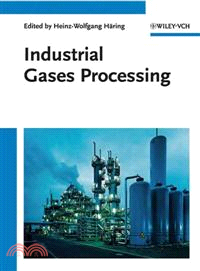INDUSTRIAL GASES PROCESSING
商品資訊
ISBN13:9783527316854
出版社:JOHN WILEY & SONS;LTD
作者:HARING
出版日:2007/12/12
裝訂/頁數:精裝/310頁
定價
:NT$ 8775 元優惠價
:90 折 7898 元
若需訂購本書,請電洽客服 02-25006600[分機130、131]。
商品簡介
作者簡介
目次
相關商品
商品簡介
Almost every modern manufacturing process relies on industrial gases, and sales of such gases are expected to rise by around 45% over the next five years.
Here, experienced and authoritative experts from one of the two world's largest producer of industrial gases impart their knowledge on atmospheric, noble and synthesized gases, carbon dioxide, LNG, acetylene and other fuel gases, as well as special and medical gases. Modern applications, e.g., the use of hydrogen in fuel cells, are included as well. This practical text is rounded off by a section on logistics.
Here, experienced and authoritative experts from one of the two world's largest producer of industrial gases impart their knowledge on atmospheric, noble and synthesized gases, carbon dioxide, LNG, acetylene and other fuel gases, as well as special and medical gases. Modern applications, e.g., the use of hydrogen in fuel cells, are included as well. This practical text is rounded off by a section on logistics.
作者簡介
Heinz-Wolfgang Härin studied chemistry at the Ludwig Maximilian University in Munich, Germany, graduating in 1972. He gained his doctorate in 1978 in metal-organic chemistry, joining Linde Engineering, a division of the current Linde Group, one year later. He was initially responsible for material selection in the various processing plants, from steamcrackers to hydrogen plants and air separation units, and for material and corrosion investigations in the event of equipment failure. In 1983, after further qualification as a welding engineer, he became head of the Material Testing Department. From here he advanced to Quality Assurance Manager in 1990, and has since held managerial posts in Materials Technology and Engineering Services Mechanical Equipment. Finally, Dr. Häring returned to chemistry and in 2001 became responsible for Chemical R&D, including the analytical services for the various process plants.
目次
Foreword.
List of Contributors.
1 Introduction.
References.
2 The Air Gases Nitrogen, Oxygen and Argon.
2.1 History, Occurrence and Properties.
2.1.1 Nitrogen.
2.1.1.1 History.
2.1.1.2 Occurrence.
2.1.1.3 Physical and Chemical Properties.
2.1.2 Oxygen.
2.1.2.1 History.
2.1.2.2 Occurrence.
2.1.2.3 Physical and Chemical Properties.
2.1.3 Argon.
2.1.3.1 History.
2.1.3.2 Occurrence.
2.1.3.3 Physical and Chemical Properties.
2.2 Recovery of Nitrogen, Oxygen and Argon.
2.2.1 Introduction.
2.2.2 Application Range of Membrane Separation, Pressure Swing Adsorption and Cryogenic Rectifi cation.
2.2.3 Nitrogen Recovery with Membranes.
2.2.3.1 Physical Principle.
2.2.3.2 Membrane Technology.
2.2.3.3 Design.
2.2.4 Nitrogen and Oxygen Recovery by Means of Pressure Swing Adsorption.
2.2.4.1 Physical Principle.
2.2.4.2 Properties of Molecular Sieves.
2.2.4.3 Nitrogen Recovery.
2.2.4.4 Oxygen Recovery.
2.2.5 Cryogenic Rectifi cation.
2.2.5.1 Process with Air Booster and Medium-Pressure Turbine for the Recovery of Compressed Oxygen, Nitrogen and Argon.
2.2.5.2 Internal Compression.
2.2.5.3 Nitrogen Generators.
2.2.5.4 Liquefiers.
2.2.5.5 High-purity Plants.
2.2.5.6 Apparatus.
2.2.5.7 Design, Assembly and Transport of the Coldbox.
2.3 Safety Aspects.
2.3.1 Introduction.
2.3.3 Air Pollution.
2.3.4 Ignition in Reboilers.
2.3.5 Other Hazards in Air Separation Units.
2.4 Process Analysis Air Separation Units.
2.5 Applications of the Air Gases.
2.5.1 Applications of Nitrogen.
2.5.1.1 Applications of Nitrogen for Inerting and Purging.
2.5.1.2 Applications of Nitrogen for Cooling, Preserving and Deep-Freezing.
2.5.2 Applications of Oxygen.
2.5.3 Applications of Argon.
3 The Noble Gases Neon, Krypton and Xenon.
3.1 History and Occurrence.
3.2 Physical and Chemical Properties.
3.3 Recovery of Krypton and Xenon.
3.3.1 Pre-enrichment in the Air Separator.
3.3.2 Recovery of Pure Kr and Xe.
3.3.2.1 Catalytic Combustion of Hydrocarbons.
3.3.2.2 Cryogenic Separation.
3.4 Recovery of Neon.
3.4.1 Pre-enrichment.
3.4.2 Fine Purification.
3.5 Industrial Product Purities and Analytics.
3.6 Applications of the Noble Gases Neon, Krypton and Xenon.
3.6.1 Applications of Neon.
3.6.2 Applications of Krypton.
3.6.3 Applications of Xenon.
4 The Noble Gas Helium.
4.1 History, Occurrence and Properties.
4.1.1 History.
4.1.2 Occurrence.
4.1.3 Physical and Chemical Properties.
4.2 Recovery.
4.3 Applications.
5 Hydrogen and Carbon Monoxide: Synthesis Gases.
5.1 History, Occurrence and Properties.
5.1.1 Introduction.
5.1.2 History of Synthesis Gas.
5.1.3 Hydrogen.
5.1.3.1 History and Occurrence.
5.1.3.2 Physical and Chemical Properties.
5.1.4 Carbon Monoxide.
5.1.4.1 History and Occurrence.
5.1.4.2 Physical and Chemical Properties.
5.2 Production of Synthesis Gas.
5.2.1 Production of Hydrogen by Electrolysis.
5.2.2 Production of Synthesis Gas from Hydrocarbons.
5.2.2.1 Generation of Synthesis Gas by Steam Reforming.
5.2.2.2 Synthesis Gas Generation by Partial Oxidation (PO).
5.2.2.3 Generation of Synthesis Gas by Autothermal Reforming (ATR).
5.2.3 Synthesis Gas Processing.
5.2.3.1 Water–Gas Shift Reactor.
5.2.3.2 Removal of Carbon Dioxide and Acid Gases.
5.2.3.3 Methanation.
5.2.3.4 Pressure Swing Adsorption (PSA).
5.2.3.5 Membrane Processes.
5.2.3.6 Cryogenic Separation Processes.
5.2.4 Processes for the Production of Synthesis Gas from Hydrocarbons.
5.2.4.1 Reformer Plant for the Production of Hydrogen.
5.2.4.2 Reformer Units for the Generation of CO and H2.
5.2.4.3 PO-plant for the Production of CO and H2.
5.3 Process Analytics.
5.4 Applications of Hydrogen, Carbon Monoxide and Syngas.
5.4.1 Applications of Hydrogen.
5.4.1.1 Hydrogen Use in the Chemical Industry.
5.4.1.2 Hydrogen as an Energy Carrier.
5.4.1.3 Fuel Cells.
5.4.2 Applications of Carbon Monoxide.
5.4.3 Applications of Synthesis Gas (Mixtures of CO and H2).
6 Carbon Dioxide.
6.1 History, Occurrence, Properties and Safety.
6.1.1 History.
6.1.2 Occurrence.
6.1.3 Physical and Chemical Properties.
6.1.4 Safety Issues.
6.2 Recovery of Carbon Dioxide.
6.2.1 Sources of Carbon Dioxide Recovery.
6.2.2 Pre-purifi cation, Enrichment, Extraction, Capture.
6.2.3 Standard Process for the Liquefaction of Carbon Dioxide.
6.2.3.1 Compression and Water Separation.
6.2.3.2 Adsorber Station.
6.2.3.3 Liquefaction and Stripping of Lighter Components.
6.2.3.4 Refrigerating Unit.
6.2.4 Process Steps to Obtain High Product Purity and Recovery Rate.
6.2.4.1 Scrubbing.
6.2.4.2 Adsorption and Chemisorption.
6.2.4.3 Catalytic Combustion.
6.2.4.4 Improvement of the Carbon Dioxide Recovery Rate.
6.2.5 Carbon Dioxide Recovery from Flue Gas.
6.2.6 Production of Dry Ice.
6.3 Applications.
7 Natural Gas.
7.1 History.
7.2 Occurrence.
7.3 Consumption.
7.4 Natural Gas Trade.
7.5 Composition.
7.6 Process of Natural Gas Treatment.
7.6.1 Dew-point Adjustment.
7.6.2 Separation of Liquefi ed Petroleum Gas.
7.6.3 Ethane Separation.
7.6.4 Liquefaction.
7.6.5 Nitrogen Separation.
7.7 Applications.
8 Fuel Gases.
8.1 Introduction.
8.2 Acetylene C2H2.
8.2.1 Acetylene and the Beginnings of Welding Engineering.
8.2.2 Physical Properties.
8.2.3 Acetylene Decomposition – Deflagration.
8.2.4 Ignitable Mixtures.
8.2.5 Liquefaction of Acetylene – Acetylene Hydrate.
8.2.6 Acetylene Hydrate.
8.2.7 Acetylides.
8.2.8 Extraction Processes.
8.2.8.1 Acetylene Generated via Carbide.
8.2.8.2 Petrochemically Generated Acetylene.
8.2.9 Gas Supply.
8.2.9.1 Storage of Dissolved Acetylene in Cylinders.
8.2.9.2 Design of a Gas Supply System.
8.2.10 Autogenous Engineering Applications.
8.2.11 Regulations.
8.3 Ethene C2H4.
8.3.1 Physical Properties.
8.3.2 Production Processes.
8.3.3 Application and Use.
8.3.4 Gas Supply and Safety.
8.3.5 Regulations.
8.4 Other Fuel Gases.
8.5 Applications.
9 Specialty Gases.
9.1 Introduction.
9.2 Pure Gases.
9.2.1 Defi nitions.
9.2.2 Quality Criteria.
9.2.3 Sources/Production.
9.2.4 Purifi cation/Processing.
9.2.5 Application Examples.
9.3 Gas Mixtures/Calibration Gas Mixtures.
9.3.1 Definitions 261
9.3.2 Production [9.9].
9.3.2.1 Technical Feasibility.
9.3.2.2 Pretreatment of Containers.
9.3.2.3 Preparation Methods.
9.3.2.4 Analytical Quality Assurance.
9.3.3 Application Examples.
9.4 Electronic Gases.
9.4.1 Defi nition/Special Demands.
9.4.2 Application Examples.
9.5 Disposal.
9.6 Transfer of Gases.
9.6.1 Selection of the Materials.
9.6.2 Physical Interaction Forces.
9.6.3 Tightness of the Gas Supply System.
9.6.4 Purging of the Gas Supply System.
10 Gases in Medicine.
10.1 Introduction.
10.2 Medicinal Oxygen.
10.2.1 Home-therapy.
10.2.2 Hospitals and Other Fields of Application.
10.3 Gases for Anaesthesia.
10.3.1 Medical Nitrous Oxide (Laughing Gas).
10.3.2 Xenon.
10.4 Medical Carbonic Acid (Carbon Dioxide).
10.5 Medical Air.
11 Logistics of Industrial Gas Supply.
11.1 Introduction.
11.2 Storage and Transport of Compressed Gases.
11.2.1 Fundamentals.
11.2.2 Kinds of Transport and Storage for Compressed Gases.
11.2.3 Effi ciency of Compressed Air Gas Transport.
11.3 Storage and Transport of Liquefi ed Compressed Gases.
11.3.1 Fundamentals.
11.3.2 Forms of Transport and Storage of Liquefied Gases.
11.3.3 Efficiency of the Transport of Liquefied Gases.
11.4 Special Forms of Supply.
Subject Index.
List of Contributors.
1 Introduction.
References.
2 The Air Gases Nitrogen, Oxygen and Argon.
2.1 History, Occurrence and Properties.
2.1.1 Nitrogen.
2.1.1.1 History.
2.1.1.2 Occurrence.
2.1.1.3 Physical and Chemical Properties.
2.1.2 Oxygen.
2.1.2.1 History.
2.1.2.2 Occurrence.
2.1.2.3 Physical and Chemical Properties.
2.1.3 Argon.
2.1.3.1 History.
2.1.3.2 Occurrence.
2.1.3.3 Physical and Chemical Properties.
2.2 Recovery of Nitrogen, Oxygen and Argon.
2.2.1 Introduction.
2.2.2 Application Range of Membrane Separation, Pressure Swing Adsorption and Cryogenic Rectifi cation.
2.2.3 Nitrogen Recovery with Membranes.
2.2.3.1 Physical Principle.
2.2.3.2 Membrane Technology.
2.2.3.3 Design.
2.2.4 Nitrogen and Oxygen Recovery by Means of Pressure Swing Adsorption.
2.2.4.1 Physical Principle.
2.2.4.2 Properties of Molecular Sieves.
2.2.4.3 Nitrogen Recovery.
2.2.4.4 Oxygen Recovery.
2.2.5 Cryogenic Rectifi cation.
2.2.5.1 Process with Air Booster and Medium-Pressure Turbine for the Recovery of Compressed Oxygen, Nitrogen and Argon.
2.2.5.2 Internal Compression.
2.2.5.3 Nitrogen Generators.
2.2.5.4 Liquefiers.
2.2.5.5 High-purity Plants.
2.2.5.6 Apparatus.
2.2.5.7 Design, Assembly and Transport of the Coldbox.
2.3 Safety Aspects.
2.3.1 Introduction.
2.3.3 Air Pollution.
2.3.4 Ignition in Reboilers.
2.3.5 Other Hazards in Air Separation Units.
2.4 Process Analysis Air Separation Units.
2.5 Applications of the Air Gases.
2.5.1 Applications of Nitrogen.
2.5.1.1 Applications of Nitrogen for Inerting and Purging.
2.5.1.2 Applications of Nitrogen for Cooling, Preserving and Deep-Freezing.
2.5.2 Applications of Oxygen.
2.5.3 Applications of Argon.
3 The Noble Gases Neon, Krypton and Xenon.
3.1 History and Occurrence.
3.2 Physical and Chemical Properties.
3.3 Recovery of Krypton and Xenon.
3.3.1 Pre-enrichment in the Air Separator.
3.3.2 Recovery of Pure Kr and Xe.
3.3.2.1 Catalytic Combustion of Hydrocarbons.
3.3.2.2 Cryogenic Separation.
3.4 Recovery of Neon.
3.4.1 Pre-enrichment.
3.4.2 Fine Purification.
3.5 Industrial Product Purities and Analytics.
3.6 Applications of the Noble Gases Neon, Krypton and Xenon.
3.6.1 Applications of Neon.
3.6.2 Applications of Krypton.
3.6.3 Applications of Xenon.
4 The Noble Gas Helium.
4.1 History, Occurrence and Properties.
4.1.1 History.
4.1.2 Occurrence.
4.1.3 Physical and Chemical Properties.
4.2 Recovery.
4.3 Applications.
5 Hydrogen and Carbon Monoxide: Synthesis Gases.
5.1 History, Occurrence and Properties.
5.1.1 Introduction.
5.1.2 History of Synthesis Gas.
5.1.3 Hydrogen.
5.1.3.1 History and Occurrence.
5.1.3.2 Physical and Chemical Properties.
5.1.4 Carbon Monoxide.
5.1.4.1 History and Occurrence.
5.1.4.2 Physical and Chemical Properties.
5.2 Production of Synthesis Gas.
5.2.1 Production of Hydrogen by Electrolysis.
5.2.2 Production of Synthesis Gas from Hydrocarbons.
5.2.2.1 Generation of Synthesis Gas by Steam Reforming.
5.2.2.2 Synthesis Gas Generation by Partial Oxidation (PO).
5.2.2.3 Generation of Synthesis Gas by Autothermal Reforming (ATR).
5.2.3 Synthesis Gas Processing.
5.2.3.1 Water–Gas Shift Reactor.
5.2.3.2 Removal of Carbon Dioxide and Acid Gases.
5.2.3.3 Methanation.
5.2.3.4 Pressure Swing Adsorption (PSA).
5.2.3.5 Membrane Processes.
5.2.3.6 Cryogenic Separation Processes.
5.2.4 Processes for the Production of Synthesis Gas from Hydrocarbons.
5.2.4.1 Reformer Plant for the Production of Hydrogen.
5.2.4.2 Reformer Units for the Generation of CO and H2.
5.2.4.3 PO-plant for the Production of CO and H2.
5.3 Process Analytics.
5.4 Applications of Hydrogen, Carbon Monoxide and Syngas.
5.4.1 Applications of Hydrogen.
5.4.1.1 Hydrogen Use in the Chemical Industry.
5.4.1.2 Hydrogen as an Energy Carrier.
5.4.1.3 Fuel Cells.
5.4.2 Applications of Carbon Monoxide.
5.4.3 Applications of Synthesis Gas (Mixtures of CO and H2).
6 Carbon Dioxide.
6.1 History, Occurrence, Properties and Safety.
6.1.1 History.
6.1.2 Occurrence.
6.1.3 Physical and Chemical Properties.
6.1.4 Safety Issues.
6.2 Recovery of Carbon Dioxide.
6.2.1 Sources of Carbon Dioxide Recovery.
6.2.2 Pre-purifi cation, Enrichment, Extraction, Capture.
6.2.3 Standard Process for the Liquefaction of Carbon Dioxide.
6.2.3.1 Compression and Water Separation.
6.2.3.2 Adsorber Station.
6.2.3.3 Liquefaction and Stripping of Lighter Components.
6.2.3.4 Refrigerating Unit.
6.2.4 Process Steps to Obtain High Product Purity and Recovery Rate.
6.2.4.1 Scrubbing.
6.2.4.2 Adsorption and Chemisorption.
6.2.4.3 Catalytic Combustion.
6.2.4.4 Improvement of the Carbon Dioxide Recovery Rate.
6.2.5 Carbon Dioxide Recovery from Flue Gas.
6.2.6 Production of Dry Ice.
6.3 Applications.
7 Natural Gas.
7.1 History.
7.2 Occurrence.
7.3 Consumption.
7.4 Natural Gas Trade.
7.5 Composition.
7.6 Process of Natural Gas Treatment.
7.6.1 Dew-point Adjustment.
7.6.2 Separation of Liquefi ed Petroleum Gas.
7.6.3 Ethane Separation.
7.6.4 Liquefaction.
7.6.5 Nitrogen Separation.
7.7 Applications.
8 Fuel Gases.
8.1 Introduction.
8.2 Acetylene C2H2.
8.2.1 Acetylene and the Beginnings of Welding Engineering.
8.2.2 Physical Properties.
8.2.3 Acetylene Decomposition – Deflagration.
8.2.4 Ignitable Mixtures.
8.2.5 Liquefaction of Acetylene – Acetylene Hydrate.
8.2.6 Acetylene Hydrate.
8.2.7 Acetylides.
8.2.8 Extraction Processes.
8.2.8.1 Acetylene Generated via Carbide.
8.2.8.2 Petrochemically Generated Acetylene.
8.2.9 Gas Supply.
8.2.9.1 Storage of Dissolved Acetylene in Cylinders.
8.2.9.2 Design of a Gas Supply System.
8.2.10 Autogenous Engineering Applications.
8.2.11 Regulations.
8.3 Ethene C2H4.
8.3.1 Physical Properties.
8.3.2 Production Processes.
8.3.3 Application and Use.
8.3.4 Gas Supply and Safety.
8.3.5 Regulations.
8.4 Other Fuel Gases.
8.5 Applications.
9 Specialty Gases.
9.1 Introduction.
9.2 Pure Gases.
9.2.1 Defi nitions.
9.2.2 Quality Criteria.
9.2.3 Sources/Production.
9.2.4 Purifi cation/Processing.
9.2.5 Application Examples.
9.3 Gas Mixtures/Calibration Gas Mixtures.
9.3.1 Definitions 261
9.3.2 Production [9.9].
9.3.2.1 Technical Feasibility.
9.3.2.2 Pretreatment of Containers.
9.3.2.3 Preparation Methods.
9.3.2.4 Analytical Quality Assurance.
9.3.3 Application Examples.
9.4 Electronic Gases.
9.4.1 Defi nition/Special Demands.
9.4.2 Application Examples.
9.5 Disposal.
9.6 Transfer of Gases.
9.6.1 Selection of the Materials.
9.6.2 Physical Interaction Forces.
9.6.3 Tightness of the Gas Supply System.
9.6.4 Purging of the Gas Supply System.
10 Gases in Medicine.
10.1 Introduction.
10.2 Medicinal Oxygen.
10.2.1 Home-therapy.
10.2.2 Hospitals and Other Fields of Application.
10.3 Gases for Anaesthesia.
10.3.1 Medical Nitrous Oxide (Laughing Gas).
10.3.2 Xenon.
10.4 Medical Carbonic Acid (Carbon Dioxide).
10.5 Medical Air.
11 Logistics of Industrial Gas Supply.
11.1 Introduction.
11.2 Storage and Transport of Compressed Gases.
11.2.1 Fundamentals.
11.2.2 Kinds of Transport and Storage for Compressed Gases.
11.2.3 Effi ciency of Compressed Air Gas Transport.
11.3 Storage and Transport of Liquefi ed Compressed Gases.
11.3.1 Fundamentals.
11.3.2 Forms of Transport and Storage of Liquefied Gases.
11.3.3 Efficiency of the Transport of Liquefied Gases.
11.4 Special Forms of Supply.
Subject Index.
主題書展
更多
主題書展
更多書展今日66折
您曾經瀏覽過的商品
購物須知
外文書商品之書封,為出版社提供之樣本。實際出貨商品,以出版社所提供之現有版本為主。部份書籍,因出版社供應狀況特殊,匯率將依實際狀況做調整。
無庫存之商品,在您完成訂單程序之後,將以空運的方式為你下單調貨。為了縮短等待的時間,建議您將外文書與其他商品分開下單,以獲得最快的取貨速度,平均調貨時間為1~2個月。
為了保護您的權益,「三民網路書店」提供會員七日商品鑑賞期(收到商品為起始日)。
若要辦理退貨,請在商品鑑賞期內寄回,且商品必須是全新狀態與完整包裝(商品、附件、發票、隨貨贈品等)否則恕不接受退貨。
























